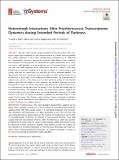Heterotroph Interactions Alter Prochlorococcus Transcriptome Dynamics during Extended Periods of Darkness
Author(s)
Biller, Steven J.; Coe, Allison; Roggensack, Sara; Chisholm, Sallie (Penny)
Downloade00040-18.full.pdf (1.946Mb)
PUBLISHER_CC
Publisher with Creative Commons License
Creative Commons Attribution
Terms of use
Metadata
Show full item recordAbstract
Microbes evolve within complex ecological communities where biotic interactions impact both individual cells and the environment as a whole. Here we examine how cellular regulation in the marine cyanobacterium Prochlorococcus is influenced by a heterotrophic bacterium, Alteromonas macleodii, under different light conditions. We monitored the transcriptome of Prochlorococcus, grown either alone or in coculture, across a diel light:dark cycle and under the stress of extended darkness-a condition that cells would experience when mixed below the ocean's euphotic zone. More Prochlorococcus transcripts exhibited 24-h periodic oscillations in coculture than in pure culture, both over the normal diel cycle and after the shift to extended darkness. This demonstrates that biotic interactions, and not just light, can affect timing mechanisms in Prochlorococcus, which lacks a self-sustaining circadian oscillator. The transcriptomes of replicate pure cultures of Prochlorococcus lost their synchrony within 5 h of extended darkness and reflected changes in stress responses and metabolic functions consistent with growth cessation. In contrast, when grown with Alteromonas, replicate Prochlorococcus transcriptomes tracked each other for at least 13 h in the dark and showed signs of continued biosynthetic and metabolic activity. The transcriptome patterns suggest that the heterotroph may be providing energy or essential biosynthetic substrates to Prochlorococcus in the form of organic compounds, sustaining this autotroph when it is deprived of solar energy. Our findings reveal conditions where mixotrophic metabolism may benefit marine cyanobacteria and highlight new impacts of community interactions on basic Prochlorococcus cellular processes. IMPORTANCE: Prochlorococcus is the most abundant photosynthetic organism on the planet. These cells play a central role in the physiology of surrounding heterotrophs by supplying them with fixed organic carbon. It is becoming increasingly clear, however, that interactions with heterotrophs can affect autotrophs as well. Here we show that such interactions have a marked impact on the response of Prochlorococcus to the stress of extended periods of darkness, as reflected in transcriptional dynamics. These data suggest that diel transcriptional rhythms within Prochlorococcus, which are generally considered to be strictly under the control of light quantity, quality, and timing, can also be influenced by biotic interactions. Together, these findings provide new insights into the importance of microbial interactions on Prochlorococcus physiology and reveal conditions where heterotroph-derived compounds may support autotrophs-contrary to the canonical autotroph-to-heterotroph trophic paradigm.
Date issued
2018-05Department
Massachusetts Institute of Technology. Department of Biology; Massachusetts Institute of Technology. Department of Civil and Environmental EngineeringJournal
mSystems
Publisher
American Society for Microbiology
Citation
Biller, Steven J., et al. “Heterotroph Interactions Alter Prochlorococcus Transcriptome Dynamics during Extended Periods of Darkness.” MSystems, edited by Olivia Mason, vol. 3, no. 3, May 2018. © 2018 Biller et al.
Version: Final published version
ISSN
2379-5077